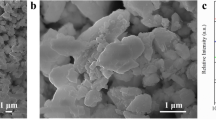Abstract
Molten magnesium oxidizes rapidly when exposed to air causing melt loss and handling difficulties. The use of certain additive gases to form a protective MgO layer over a magnesium melt has been proposed. The oxidation behavior of molten magnesium in air that contains various concentrations of CO2 was investigated, including the kinetics of the oxide layer growth. Experiments were performed using a thermogravimetric analysis unit in the temperature range of 943 K to 1043 K (670 °C to 770 °C). Results showed that a thin, coherent, and protective MgO-C layer was formed under the test conditions. The thicknesses of this layer formed under CO2/air ranged from 500 nm to 12 μm. Rate parameters were calculated and a model for the process was developed. The morphology and composition of the surface films were studied using SEM and EDS.












Similar content being viewed by others
References
J.W. Fruehling: Ph.D. Thesis, University of Michigan, Ann Arbor, Michigan, 1970.
N. B. Pilling and R. E. Bedworth: Journal of the Institute of Metals, 1923, vol. 29, 529-591.
H. E. Friedrich and B. L. Mordike: Magnesium Technology, Springer, New York, 2006.
S.P. Cashion: Ph.D. Thesis, The University of Queensland, Brisbane, Australia, 1999.
E. F. Emley: Principles of Magnesium Technology, Pregamon Press, Oxford, 1966.
S. Couling, T. Leontis: Light Metals, 1980, vol. 4, 997-1009.
J.D. Hanawalt: US Patent No 4,089,678. Ann Arbor, MI, U.S. Patent and Trademark Office, 1978.
K. Aarstad: Ph.D. Thesis, Norwegian University of Science and Technology, Trondheim, Norway, 2004.
F.W. Bach, A. Karger, C. Pelz, and M. Schaper: Magnesium Technology, TMS, 2005, pp. 3–6.
P. Biedenkopf, A. Karger, L. Michael, and W. Schneider: Magnesium Technology, TMS, 2005, pp. 39–42.
Outokumpu HSC: Chemistry 5.1 for Windows—Chemical Reaction and Equilibrium Software with Extensive Thermochemical Database, Outokumpu Research Oy, Pori, Finland, 2002.
Z. Yuan and H. Y. Sohn: ISIJ International, 2014, vol. 54(6): 1235–43.
D. R. Wall and H. Y. Sohn: J. Amer. Ceram. Soc., 1990, vol. 73, 2944–2952.
H.Y. Sohn and D. Kim: Metall. Trans. B, 1987, vol. 18B, 451–457.
J. Szekely, J. W. Evans, and H. Y. Sohn: Gas-Solid Reactions, Chapter 6. Academic Press, New York, pp. 209-213, 1976.
S. Emami, H. Y. Sohn, H. G. Kim: Metall. Mater. Trans B, 2013, vol. 45B:1370–79. Doi: 10.1007/s11663-014-0059-2.
H. Wang and H. Y. Sohn, Metall. Mater. Trans. B, 2013, vol. 44B, 133-145. Doi: 10.1007/s11663-012-9754-z.
J. M Smith: Chemical Engineering Kinetics, 2 nd ed., McGraw-Hill, New York, 1970, pp. 337, 349.
J. Kestin, K. Knierim, E.A. Mason, B. Najafi, S.T. Ro, and M. Waldman: J. Phys. Chem. Ref. Data, 1984, vol. 13, pp. 229–303.
Author information
Authors and Affiliations
Corresponding author
Additional information
Manuscript submitted April 24, 2014.
Appendix A
Appendix A
Evaluation of CO2 Diffusion Through the MgO Layer
Let us assume that the diffusion of CO2 through the non-protective MgO layer was the rate-controlling step. In this case, as soon as CO2 reached the Mg surface, Reaction [2] would take place rapidly. The rate of CO2 diffusion is given by the following Fick’s law:
The diffusion rate is then related to the growth rate of carbon layer by the following relationship:
where L MgO/C = thickness of the protective layer, t = reaction time, D = diffusion coefficient, \( C_{{{\text{CO}}_{2} ,b}} \) = equilibrium concentration of CO2 at the gas/oxide interface, \( \rho_{{{\text{MgO}}/{\text{C}}}} \) = moles of C per unit volume of MgO-C (mol/cm3). (Note that \( 1/\rho_{{{\text{MgO}}/{\text{C}}}} \) represents the volume of the MgO-C layer per 1 mol of C contained therein.) The effective diffusivity of CO2 can be estimated by:[19]
where ε is the porosity of the non-protective MgO layer. In this work it was calculated to be ~0.65 to 0.70. A much more accurate value of diffusivity is not warranted because we are verifying the fact that the diffusion rate is much greater than the observed reaction rate. When the MgO-C layer thickness increased from 4.48 to 2.50 μm in 4 minutes of exposure to 90 vol pct CO2 in air at (993 K) 720 °C, the experimental growth rate was ~8 × 10−7 cm/s. However, a growth rate of ~1.95 × 10−3 cm/s was calculated using Eq. [A2] with the effective diffusivity value computed from Eq. [A3]. The growth rate under diffusion control would be orders of magnitude faster than the experimental growth rate, indicating that the chemical reaction of forming the MgO-C layer was rate-controlling and CO2 diffusion through the porous MgO layer did not affect the overall rate.
Comparison was made for the fastest rate of MgO-C layer growth determined in this work to ensure the validity of this conclusion. The loose and porous structure of magnesium oxide observed under a microscope also supports this conclusion.
Rights and permissions
About this article
Cite this article
Emami, S., Sohn, H.Y. Formation and Evaluation of Protective Layer over Magnesium Melt Under CO2/Air Mixtures. Metall Mater Trans B 46, 226–234 (2015). https://doi.org/10.1007/s11663-014-0167-z
Published:
Issue Date:
DOI: https://doi.org/10.1007/s11663-014-0167-z




